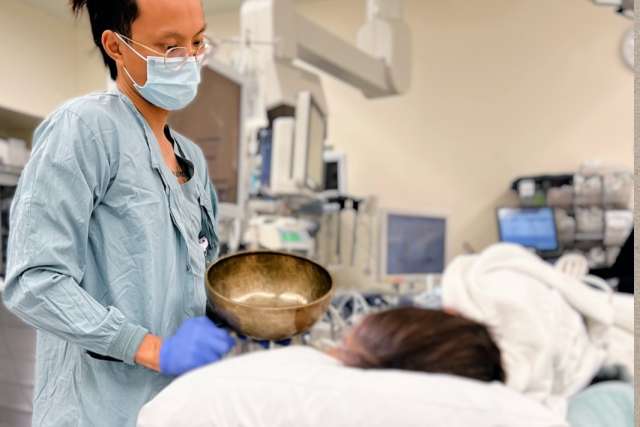There are a few things you expect when preparing to undergo general anesthesia: fasting, probably an IV, maybe a twinge of worry.
What you probably wouldn’t anticipate is a bedside sound bath provided by your anesthetist to help calm your nervous system.
UCLA Health nurse anesthetist Huy Vo, CRNA, has offered bedside sound bath experiences to patients before providing anesthesia since 2017. That’s when the longtime meditator and yoga practitioner started bringing a small Tibetan singing bowl – a metal vessel that makes a resonant sound when struck – with him to work.
Vo says he was looking for a way to “humanize” the perioperative experience for patients, who may feel unnerved in a clinical setting, with its bright lights and beeping monitors.
“We have everything in place to make our patients physically safe, but we’re not tending to their emotional safety,” Vo said during a recent shift at Ronald Reagan UCLA Medical Center, one of the six surgical centers he rotates between.
Studies show sound bath experiences are calming, even for people who have never tried them before. Still, Vo was apprehensive when he first brought the singing bowl to work.
“I just wasn’t sure how it would be received by staff or even the patients,” Vo said. “But, to my surprise, patients loved it and so did my colleagues.”
Vo’s toolkit of calming modalities – and his understanding of the nervous system – has only grown since then.
Integrative modalities in action
During a recent shift providing anesthesia for patients undergoing colonoscopies, one woman confessed she was particularly nervous. Vo stood by her bed, listening to her talk about a recent concert she’d attended, as he folded and twisted white hand towels into the shape of a turtle – the kind of towel creation you might find on the bed in a tropical hotel room. He dabbed the turtle’s “face” with lavender essential oil, which has been shown to reduce anxiety, and handed it to the patient.
“We’re going to summon some spirit animals,” Vo playfully told her. “You’re giving me turtle vibes.”
“It looks more like a bunny,” she said, nuzzling the impromptu stuffed animal and taking a deep whiff of its lavender scent.
As the anesthesia dripped into the IV in her arm, Vo played the sound bowl directly above her chest.
“It lets that sound envelop them,” he explained.
About 20 minutes later, the procedure complete, nurses were wheeling the patient’s bed to the recovery area when she turned to Vo and said, “Thank you for the sound bath!”
Connecting with vulnerability
Vo was drawn to nursing for the opportunity it provides to “take care of people at their most vulnerable,” he said. “There’s just something about that that feels really human.”
But he noticed that the unyielding pace of modern medicine – one patient after another, all day long – didn’t always make space for a true human connection, that aspect of his work he loves most.
So Vo drew on his longstanding spiritual practice and endless curiosity about consciousness and human nature to find ways to create that space. He’d invite his colleagues to pause and take a few breaths together as each new patient came in, “just to help contextualize what we’re doing, as opposed to getting lost in what can sometimes feel like an assembly-line experience.”
It worked. They felt more connected to each other, the people they cared for and “the aliveness of the moment,” Vo said.
He was inspired to dig deeper, to learn more about the nervous system and explore what could create more ease and grounding in the medical setting. That’s when he started bringing his singing bowl to work. He later added essential oils and a mini projector that creates soothing light patterns on the walls and ceiling.
Outside the hospital, he studied somatic experiencing, a therapeutic model that leverages physical sensations to calm the mind, and polyvagal theory, which explains nervous system function and how to return to a more regulated state.
“As I began to deepen my training, I developed a deeper understanding of how to engage those (calmer nervous system) pathways to create this more regulated, attuned space,” Vo said.
Spreading the word
Vo’s colleagues now know to expect integrative modalities on their shifts together, which makes them feel calmer and more connected. He even hosts special sound baths just for staff. Vo has been invited to speak about his approach at Stanford University, anesthesia conferences and the Integrative Medicine Collaborative at UCLA Health.
Anecdotally, he has noticed that patients require less medication when integrative modalities – sound, light projection, essential oils – are part of pre-anesthesia care. He’d eventually like to participate in a controlled study to verify those observations.
Meanwhile, adding a dash of lavender oil and a little singing-bowl sound has made his work feel more meaningful and his days more harmonious.
“It really is about connection for me,” he said. “To be able to discover how I can feel a deep and profound connection with patients, and even my colleagues, on this energetic level, and even in a space (like the hospital), it’s everything. It just feels so nourishing and nurturing.”




